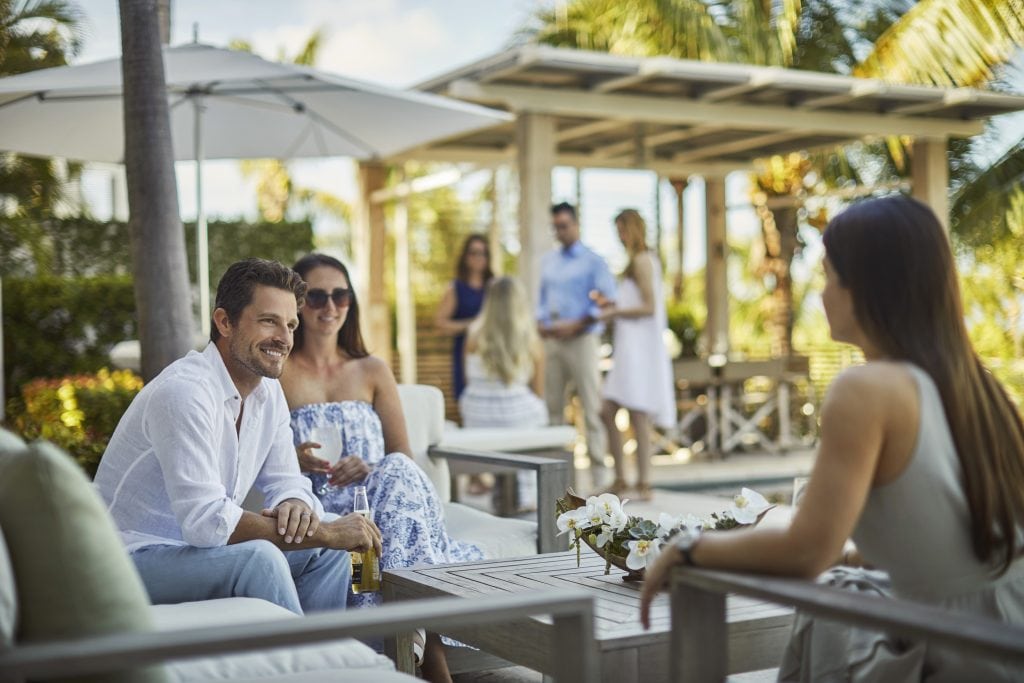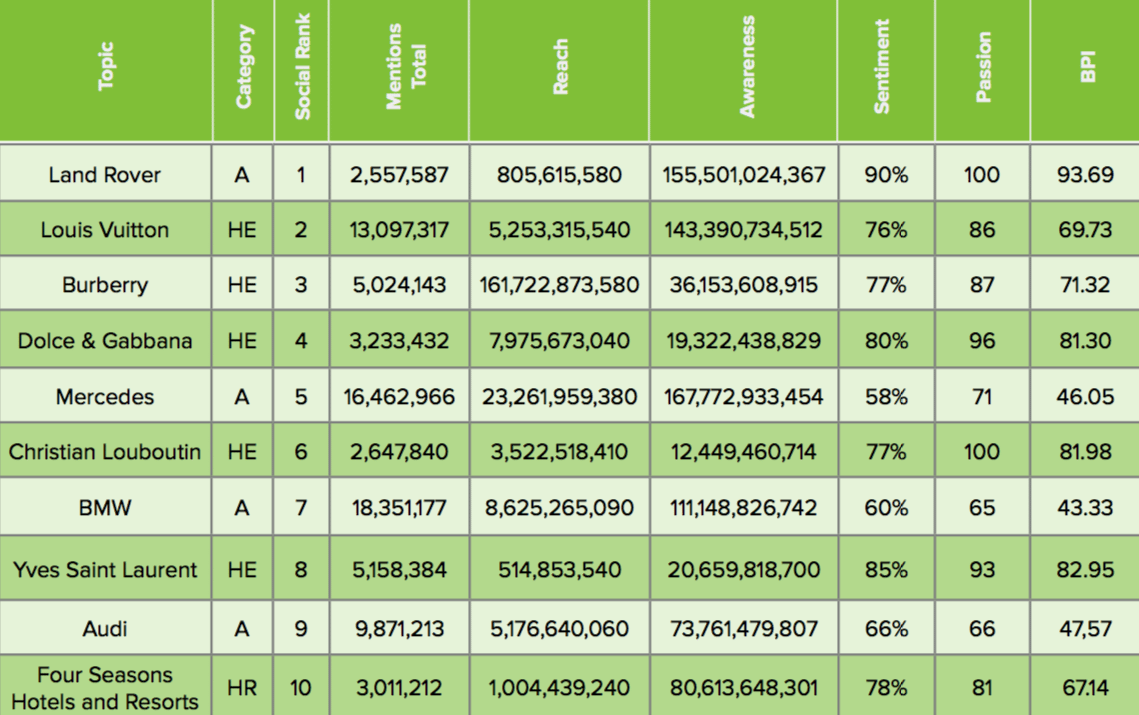Skift Take
Social platforms are constantly evolving, mandating that luxury brands perpetually refine their approach and balance their agenda of pushing a lifestyle brand while providing real-time customer communications.
Hospitality brands should arguably be the most personable and refined of communicators on social media, but translating the in-person service to digital is not always a straight path. Within the luxury space, hospitality brands have unfortunately been known to lag behind leaders in fashion and accessories when it comes to social intelligence.
A new report from social analytics company Netbase, Social Media Industry Report 2018: Luxury Brands, examines the state of luxury brands’ social acuity. In a ranking of 100 brands, only two hospitality brands — Four Seasons Hotels and Resorts and The Ritz-Carlton Hotel Company — ranked among the top 50 luxury brands on social.
Netbase used conversation volume, awareness as measured by earned impressions, reach as measured by owned impressions, net sentiment, and brand passion to measure the different companies.
To better understand this analysis, we look at how luxury hotels are capitalizing on social media interactions to build up brands and foster customer relationships — especially in relation to other luxury brands outside the travel space.
Utility First and Foremost
Hotels account for only 4 percent of measured conversations compared to automobiles, which account for 45 percent, or high-end brands, which account for 40 percent, of share of voice in the report. This suggests that viral conversations can have an outsized impact on a brand’s reputation on social — something luxury communicators are well aware of.
“Consumer engagement is incredibly important to us,” Lisa Holladay, global brand leader for Ritz–Carlton, said.
“In addition to creating beautiful stories for our channels that inspire travel and promote the Ritz-Carlton properties and destinations, we want to be conversing with our consumers in real time on the platforms that are most important to them,” she said. “This means we must work closely with our properties to ensure we are sharing the right messaging on the right platform at the right time.”
Managing the sheer volume of inbound and outbound messages has, however, become a significant challenge for many brands, explained Stephanie Bridge, manager of social media marketing at Four Seasons Hotels and Resorts.
“Across industries, many companies have turned to automation technologies and ‘bots’ to cope with the load, which has made many consumer interactions with brands feel scripted and impersonal,” Bridge said.
“At Four Seasons, our goal has been to create a digital environment that is a natural extension of our hotels and resorts around the world, bringing our genuine and personalized service promise to the social sphere.”
That means Four Seasons’ social teams monitor an individual social media presence for each of the brand’s 110 hotels and resorts — without the aid of chatbots.
Beyond Response
Outside of social media’s functionality as a communication tool, Elvis Lieban, Netbase´s director of social insights, argues that luxury hotels have to go beyond the use of platforms as customer care portals.
“Luxury brands in the fashion world do a wonderful job promoting a luxury lifestyle and, from what we found in the report, hospitality businesses could do more to promote the lifestyle around their business rather than just the property or service itself,” Lieban said.
“Our top performers weren’t just promoting products, they were promoting a luxury lifestyle,” he said. “Hospitality brands could not only look for inspiration from the other brands, they could look for partnership opportunities and partner with other luxury brands to show how their brand fits into a luxury lifestyle.”
Bridge often looks to fashion brands’ lifestyle success on social, calling out how Tiffany & Co. uses social media channels to “simultaneously convey the brand’s heritage and craftsmanship, while leveraging a social-first visual storytelling approach that is playful and full of personality” as well as Burberry’s leadership in ushering in “a new era for luxury brands with their early user-generated content experimentation and the blending of the digital and physical worlds.”
“We admire luxury brands that have been able to translate consumer passion into robust and highly engaged digital communities. In particular, we look to those that have been able to capitalize on the endless opportunities for innovation social media affords while staying true to their heritage and core values,” Bridge said.
However, designing lifestyle content becomes more nuanced when considering luxury company’s diverse audiences.
“As a global brand, we are speaking to a global audience and different regions and destinations respond to and engage with social content differently,” Holladay said. “For example, food and beverage photos and posts will do better in certain markets while images with or without people will speak to different audiences. It is important to evaluate the exact audience we want to reach and make sure that the asset, caption, channel, and timing targets this group.”
She continued: “People’s tastes are also constantly changing and evolving, so what worked well last year may no longer resonate. It all comes down to knowing your audience and presenting them with high-quality, thoughtful content that really captures the story we want to tell.”
Insights Out of Data
Mining the endless streams of conversations represents both a giant opportunity and challenge for hospitality brands.
“When you have a social presence as large and nuanced as the Ritz-Carlton, it creates a lot of data to consider and manage,” Holladay said. “There is a wealth of information we can get from social media and not just from our own channels.”
One of the most important data points to look at for luxury brands is share of voice, argues Lieban.
“Share of voice is especially important relative to competitors – having more share of voice means you’re more likely to be top of mind when your audience is planning their next purchase,” he said. “Measuring likes on Instagram isn’t the right way to think about it. Brands need to measure whether or not they’re accessing and engaging their target audience on social media, and whether those interactions are helping move the customer through to purchase.”
This isn’t the first article or last article we’ll write on how luxury brands are capitalizing on the opportunities that social presents, because as Bridge concludes, “One of the most exciting things about social media – the speed at which it evolves, and, consequently, the never-ending opportunities for innovation it affords – is also one of the most challenging elements.”
The Daily Newsletter
Our daily coverage of the global travel industry. Written by editors and analysts from across Skift’s brands.
Have a confidential tip for Skift? Get in touch
Tags: four seasons, luxury, ritz-carlton, social media
Photo credit: Four Seasons Resort and Residences Anguilla. The company was one of only two hospitality brands to make it into the top 50 of the study. Four Seasons Hotels and Resorts

